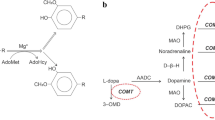Abstract
Effects of YM-14673 (Nα-[{(S)-4-oxo-2-azetidinyl}-carbonyl]-l-histidyl-l-prolinamide dihydrate), a new TRH derivative, on reserpine-induced behavioural and electroencephalographic changes were observed in comparison with those of TRH. YM-14673 antagonized reserpine-induced hypothermia and decrease in convulsion threshold in mice. The number of PGO waves recorded from the lateral geniculate body was decreased by administration of YM-14673 in reserpinized cats. The anti-reserpine activity of intravenous YM-14673 was about 8–20 times more potent than that of TRH. In inhibiting reserpine-induced hypothermia, the oral ED2°C relative to IV ED2°C as an indirect indication of absorption rate of the drugs was 15 for both YM-14673 and TRH. These results suggest that YM-14673 possesses more potent facilitatory effects on the central monoamine systems than TRH.
Similar content being viewed by others
References
Anderson JL (1983) Serotonin receptor changes after chronic antidepressant treatments: ligand binding, electrophysiological and behavioral studies. Life Sci 32:1791–1801
Boggan WO (1973) Serotonin and convulsions. In: Barchas J, Usdin E (eds) Serotonin and behavior. Academic Press, New York, London, pp 161–172
Breese GR, Copper BR, Prange AJ, Cott JM, Lipton MA (1974) Interactions of thyrotropin-releasing hormone with centrally acting drugs. In: Prange AJ (ed) Thyroid axis, drugs and behavior. Raven Press, New York, pp 115–127
Brewster D, Dettmar PW, Metcalf G (1981) Biologically stable analogues of TRH with increased neuropharmacological potency. Neuropharmacology 20:497–503
Carlsson A, Corrodi H, Fuxe K, Hokfelt T (1969a) Effect of some antidepressant drugs on the depletion of intraneuronal brain catecholamine stores caused by 4,β-dimethyl-metatyramine. Eur J Pharmacol 5:367–373
Carlsson A, Corrodi H, Fuxe K, Hokfelt T (1969b) Effect of antidepressant drugs on the depletion of intraneuronal brain 5-hydroxytryptamine stores by 4-methyl-β-ethyl-meta-tyramine. Eur J Pharmacol 5:357–366
Cott JM, Breese GR, Copper BR, Barlow TS, Prange AJ (1976) Investigations into the mechanism of reduction of ethanol sleep by thyrotropin-releasing hormone (TRH). J Pharmacol Exp Ther 196:594–604
Doi T, Saji Y, Nagawa Y (1978) Facilitatory actions of thyrotropin-releasing hormone (TRH) in cats subjected to destruction of the hypothalamus. Jpn J Pharmacol Ther 6(11):23–32 (in Japanese)
Green AR, Grahame-Smith DG (1976) Effects of drugs on the processes regulating the functional activity of brain 5-hydroxytryptamine. Nature 260:487–491
Hawkins DF (1964) Observations on the application of the Robbins-Monroprocess to sequential toxicity assays. Br J Pharmacol 22:392–402
Kastin AJ, Ehrensing RH, Schalch DS, Anderson MS (1972) Improvement in mental depression with decreased thyrotropin response after administration of thyrotropin releasing hormone. Lancet II:740–742
Koella WP, Feldstein A, Czicman JS (1968) The effect of parachlorophenylalanine on the sleep of cats. Electroencephalogr Clin Neurophysiol 25:481–490
Manaka S, Sano K (1977) Effects of thyrotropin releasing hormone tartrate (TRH-T) on disturbance of consciousness following head injury in mice. Igaku No Ayumi 102:867–869 (in Japanese)
Metcalf G (1982) Regulatory peptides as a source of new drugs — the clinical prospects for analogues of TRH which are resistant to metabolic degradation. Brain Res Rev 4:389–408
Miyamoto M, Fukuda N, Narumi S, Nagai Y, Saji Y, Nagawa Y (1981) r-Butyrolactone-r-carbonyl-histidyl-prolinamide citrate (DN-1417): a novel TRH analog with potent effects on the central nervous system. Life Sci 28:861–869
Nagai Y, Narumi S, Saji Y, Nagawa Y (1985) A TRH analog (DN-1417). Anti-reserpine action in electroconvulsive threshold and involvement of serotonergic mechanism in mice. Folia Pharmacol Jpn 85:221–230 (in Japanese)
Prange AJ, Loosen MD, Nemeroff CB (1979) Peptides: application to research in nervous and mental disorders. In: Fielding S, Ettland RC (eds) New frontiers in psychotropic drug research. Futura, Mount Kisco, NY, pp 117–189
Rastogi RM (1979) Thyrotropin-releasing hormone influences on behavior: possible involvement of brain monoaminergic systems In: Collu R, Ducharme JR, Rochefort JG, Barbeau A (eds) Central nervous system effects on hypothalamic hormones and other peptides. Raven Press, New York, p 123
Roubicek J, Geiger CM, Abt K (1972) An ergot alkaloid preparation in geriatric therapy. J Am Geriatr Soc 20:222–229
Ruch-Monachon MA, Jalfre M, Haefely W (1976) Drugs and PGO waves in the lateral geniculate body of the curarized cat, 2. PGO wave activity and brain 5-hydroxytryptamine. Arch Int Pharmacodyn 219:269–286
Sano K (1979) Clinical studies on thyrotropin releasing hormone tartrate for the treatment of disturbance of consciousness. Adv Neurol Sci 23:184–210 (in Japanese)
Schildkraut JJ (1973) Neuropharmacology of the affecting disorders. Annu Rev Pharmacol 13:427–454
Simon RP, Gershon MD, Brooks DC (1973) The role of the raphe nuclei in the regulation of ponto-geniculo-occipital wave activity. Brain Res 58:313–330
Snider R, Niemer WT (1961) A stereotaxic atlas of the cat brain. University of Chicago Press
Yamamoto M, Shimizu M (1987a) Effects of a new TRH analogue, YM-14673 on central nervous system. Naunyn Schmiedebergs Arch Pharmacol 336:561–565
Yarbrough GG (1979) On the neuropharmacology of thyrotropin releasing hormone (TRH). Prog Neurobiol 12:291–312
Yokohama S, Yamashita K, Toguchi H, Takeuchi J, Kitamori N (1984) Absorption of thyrotropin-releasing hormone after oral administration of TRH tartrate monohydrate in the rat, dog and human. J Pharm Dyn 7:101–111
Zuger PE, Vigouret JM, Loew DW (1978) Inhibition of reserpine-induced PGO waves in the cat by ergot derivatives. Experientia 34:637
Author information
Authors and Affiliations
Rights and permissions
About this article
Cite this article
Yamamoto, M., Shimizu, M. & Iwai, A. Antagonizing effects of YM-14673, a new TRH derivative, on behavioral and electroencephalographic changes in reserpinized animals. Psychopharmacology 95, 162–166 (1988). https://doi.org/10.1007/BF00174502
Received:
Revised:
Issue Date:
DOI: https://doi.org/10.1007/BF00174502




